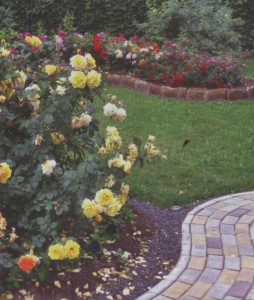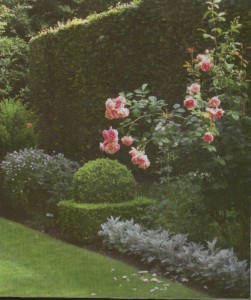If you do not want or can not use the services of a landscape architect, you can design your garden yourself, in accordance with your understanding and its requirements. But before transferring all this to paper, you need to imagine how and where you will place plants.
For each site there is a plan. This is a "card" that shows the form and  the size of your property, the location of the house and other buildings on the scale. You can sometimes do without scale, but with detailed layout it will still be necessary.
the size of your property, the location of the house and other buildings on the scale. You can sometimes do without scale, but with detailed layout it will still be necessary.
If there is no area plan, sketch at least a rude sketch of the territory of your possessions and place all existing objects, starting at home and ending with the main trees and shrubs that plan to leave on this site. Be sure to determine the parties of the world on the plan. Pay attention to too dry or
Wet places, solar and shady, as well as on the exposure of the site with prevailing winds.
Before you start planning, it is important to determine how you want to see the garden. At the same time, it is necessary to take into account the style of the house, our own views and lifestyle. Decide how to use the Earth, whether the playground is needed, pets, parking, a picnic area, tracks. Should the site be hidden from prying eyes or, on the contrary, - foreseeable. All this to start is displayed on paper to subsequently do not redo directly in the garden. Of course you need to get the necessary instruments for working in the garden: shovels of different species, rakes, all kinds of buckets, buy trimmer - Manual lawn mower, chippers, secateurs for chickens of trees and shrubs and much more.
See other, existing gardens. Pay attention to what would like to see and have in your own garden. Of course, you will not find exactly what they say a bunch of ideas and information that then use.
There are quite many articles with color photos and some sketches of plans for different sites already with a selected range of plants. Some of them even give the average value estimates of those or other materials.
Landscaping in shady

The soil should be well water and breathable, since the sun can not dry it completely. Add the organic (compost, peat, sand) to improve drainage properties.
The lack of the Sun allows the soil to remain wet longer, and this aggravates the problems of weak growth and mushroom diseases. To avoid such problems, increase the distance between the plants, making it more than usual. This will allow each plant to get its share of light and nutrients and improve breathability.
Since the shady gardens are wet, in the interval between irrigation, the land should be completely sinking completely.
Plants that need more water in the soil must be meditated.
Every 4-6 weeks feed a balanced fertilizer.
When planting plants among the trees, take into account the compatibility of their need for water, since not all trees and shrubs carry excessive humidity leading to growth inhibition, and even to the death of the plant.
The concept of height and width
When placing the highest plants in the background or in the center of the flower bed, the height of the rest should gradually decline to the boundaries. Books, reference books and colored labels on plants usually give the size of the middle height during flowering. Remember that a lot of green pets are much longer than foliage, which means that the plant outside the flowering can be much lower than the height label.
It must be said that the height (as well as the width) is also averaged concept. When the plant grows in the poor, dry soil, it can only be half the height of the instance growing in rich, damp soil.
The width of the plant is as important. The actual value varies depending on the soil, geographic location and age of the plant itself. Be careful, having relatively slowly slow-growing plants with fast-growing, the latter can drown out neighbors by the end of the season. Intervals between plants

A more successful reception is to place short-lived plants between slowly growing. For example, most peonies take about seven years to achieve the present size. Therefore, in the aisle, annually, until they grow up, you can plant beautifully mixing annuals in a duet, for example, with daisies.
The garden, in which groups of five or more plants of one variety are planted, will be released by repeated colors and structures. In such a type of garden, plants are used primarily as modules that constitute the overall combined visual effect.
In contrast, it is a garden filled with completely different types and varieties. This option is suitable for those who want to have everything and gradually. The type of such a garden may seem disorderly, but it is fairly easy and quick to create.
Endurance of green pet
If the plant is enemora-resistant, it is most likely in the middle climatic zone, the winter will not survive. It is necessary to take into account the height of the site, the level of groundwater, from which side of the light it is purged with cold winds, the composition of the soil. Yes, and the height of the snow
Pokrov also has an important meaning for wintering plants,
For the perfect result, choose plants that winter in our climate. Of course, you will want any exotics not for our latitudes. The seller will assume that this plant is good in winter, but only you need to strengthen it in the first years. Do not share, at best, this plant above the snow level will freeze. And this is subject to high snow cover. And it may not suffer so much from frosts, how many from the wearing winter winds. Well, in the worst case you will have to throw.
Gardeners of more northern areas are interested in minimal temperatures that the plant transfers, and in southern latitudes pay attention to the maximum temperatures. Many popular perennials (for example, lupins, peonies, phlox), which do not feel very well in the warm climate. They need low temperatures for good floral kidney bookmark. Other perennials do not withstand long-term heat and humidity.
Color selection
In working with the color you need to strive for the balance of integration and contrast. A large number of one color may look monotonously, and the wrong selection of different colors - to be an unpleasant eye. You can organize your garden in both one color, choosing pastel, cold or warm and bright colors, and experiment with different colors. For example, bright, as if inviting, tones before the main entrance and cool - in a more quiet area of \u200b\u200bthe site.
Remember that not many plants bloom more than a few weeks per season. Most time they are green. And if you are only interested in the all-season flowering garden, you should choose plants of different blossoms.
Ideas for Garden
Comments leave a comment
 Start a discussion ...
Start a discussion ...












